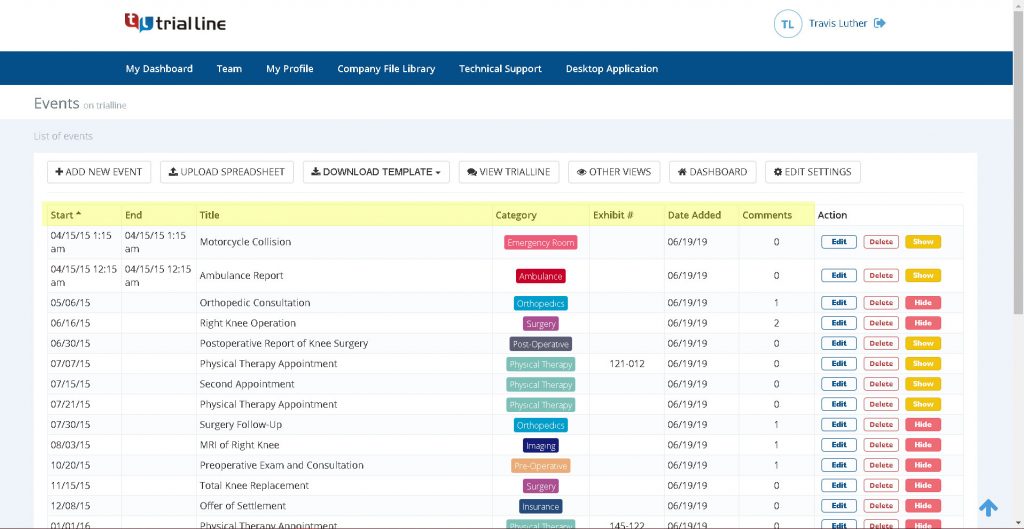Medical malpractice cases depend on clear, well-documented evidence. Lawyers must show how a provider’s actions led to a patient’s injury.
With thousands of medical malpractice cases filed each year in the US, an organized medical chronology can be a deciding factor in legal proceedings.
Using a medical chronology template, attorneys can quickly organize medical events in chronological order. This simplifies the case discovery process, helps identify missing medical records, and provides a concise format that supports legal arguments.
In this article, you will learn how a chronology template helps legal professionals organize medical documents, review medical malpractice cases, and build strong evidence for legal proceedings.
Present Stronger Cases with a Clear Medical Timeline—Try TrialLine Today!
What Is Medical Malpractice?
When a healthcare provider acts negligently, it can lead to malpractice, causing harm to a patient or worsening their condition. This negligence can happen through misdiagnosis, surgical errors, medication mistakes, or failure to provide appropriate treatment.
For a malpractice case to be valid, the provider’s actions must deviate from standard medical practices, directly causing harm to the patient. It includes several key parties and legal processes:
- Plaintiff – The injured patient or their representative filing the lawsuit.
- Defendant – The healthcare provider accused of negligence. This could be a physician, nurse, hospital, or any medical professional involved in the patient’s care.
- Prevailing party – The party that wins the case, whether it is the plaintiff proving negligence or the defendant successfully defending their actions.
- Losing party – The party that does not succeed in the legal proceedings.
- Fact-finder – The judge or jury responsible for reviewing medical evidence and deciding the outcome.
What Are the Four Elements of Medical Malpractice?
For a malpractice case to succeed, attorneys must prove four key elements: duty, breach of duty, causation, and damages.
Duty
A healthcare provider has a legal obligation to provide care that meets accepted medical standards. This duty applies to physicians, nurses, surgeons, and other medical professionals.
A provider’s duties include:
- Diagnosing and treating patients properly based on their medical record summary and symptoms
- Following standard medical procedures to avoid harm
- Providing timely medical intervention to prevent worsening conditions
- Communicating risks, medical terms, and treatment options clearly to patients
- Referring patients to specialists when necessary for proper evaluation
Breach of Duty
A breach of duty happens when a provider fails to meet medical standards. This could involve:
- Misdiagnosing a patient’s medical history or symptoms
- Performing unnecessary procedures
- Administering the wrong treatment
- Delaying medical intervention
Causation
Causation links the provider’s actions to the patient’s injury. Proving this connection requires more than showing that a mistake occurred.
To establish causation, legal teams must:
- Analyze the patient’s past medical history to rule out pre-existing conditions
- Compare treatment outcomes to determine if the provider’s actions deviated from standard care
- Identify treatment gaps that show a delay or lack of necessary medical intervention
- Review X-rays, lab results, and test reports to highlight errors or missed diagnoses
- Consult medical experts to interpret relevant information and confirm the connection between negligence and harm
Damages
Damages refer to the harm suffered by the patient due to negligence. These can include:
- Physical injury (worsening condition, permanent disability)
- Emotional distress (anxiety, PTSD)
- Financial losses (medical bills, lost wages)
- Future treatment costs (rehabilitation, long-term care)
Why Do Lawyers Use a Medical Record Chronology Template for Malpractice Cases?
To open the sample timeline in a new window, click here (best option). To view the embedded sample TrialLine in the window below, click “more” to open events and use your up/down left/right arrow keys to navigate. You may also grab and “drag” the background to move events around.
A medical chronology report template is a structured format that helps lawyers organize and summarize medical records in a detailed timeline.
Below are the main reasons why legal professionals use a chronology template when handling malpractice cases.
Make Medical Chronologies Clear and Persuasive—Book a TrialLine Demo Now!
Organizing Medical Records for Faster Case Review
Sorting through hundreds of pages of medical history is time-consuming. Without a structured approach, attorneys may spend hours searching for key details like a specific procedure date, a provider name, or a significant medical event.
A chronology template eliminates this problem by providing a framework for legal professionals to input and categorize relevant information in an accessible format.
For instance, an attorney handling a personal injury case may need to pinpoint when a patient first reported symptoms.
Instead of flipping through disorganized medical records, the template presents the necessary medical evidence in a structured format. This allows the legal team to focus on case strategy rather than administrative tasks.
Reducing Errors and Inconsistencies in Medical Evidence
Manually compiling medical records increases the risk of missing significant events or overlooking treatment gaps. Using a template ensures that no key details are left out.
By using predefined sections, attorneys can systematically document each procedure, provider, diagnosis, and outcome in a way that aligns with legal needs.
For example, if a malpractice lawsuit involves a delayed diagnosis, an attorney must prove that a healthcare provider failed to act in a timely manner.
A chronology template allows legal professionals to track the time between initial symptoms, medical evaluations, and final diagnoses, helping them establish negligence more effectively.
Simplifying Communication With Medical Experts
A malpractice case often requires medical experts to review records and provide opinions on whether a healthcare provider followed standard practices.
However, experts are not always available for extended consultations, and disorganized records can delay their assessments.
A template simplifies this process by providing a concise format that highlights legally significant medical events. Instead of handing over stacks of paperwork, attorneys can present a medical record summary that directs experts to key points within the patient’s medical history.
Improving Case Presentation
Lawyers must present medical evidence in a way that is clear and persuasive. A template helps attorneys organize information so it can be easily referenced in court.
Whether cross-examining witnesses, arguing liability, or negotiating settlements, attorneys can confidently support their claims with an organized record of medical events.
For example, if a patient claims that a surgical error caused long-term complications, an attorney using a template can immediately reference the surgical history, post-operative records, and follow-up treatment.
Maximizing Efficiency in Mass Tort and Complex Litigation
In cases involving multiple plaintiffs, such as mass tort lawsuits, managing large volumes of medical records becomes even more challenging.
For instance, in a mass tort case involving defective medical implants, lawyers must demonstrate how various patients suffered similar complications.
Using a template, attorneys can efficiently categorize treatment outcomes, track recurring medical events, and compare different medical records to build a stronger argument.
Saving Time and Resources
Time is a valuable resource in litigation, and spending hours manually compiling medical history is not practical. A template significantly reduces administrative workload by providing a structured way to record, retrieve, and analyze medical records.
Instead of starting from scratch using word processing software for every new case, lawyers can use a template to quickly input relevant information. This approach not only saves time but also enhances accuracy.
By using a template, attorneys also reduce the risk of missing medical records, duplicating information, or overlooking significant events that could impact a case’s outcome.
How to Build a Medical Chronology Template Using TrialLine
Lawyers can streamline the case discovery process by using legal tools like TrialLine instead of manually compiling scattered medical documents.
Step 1: Set Up Your Case in TrialLine
The first step involves creating a new case in TrialLine, where all records and timelines will be organized. To begin:
- Log in to your TrialLine account or create a new one.
- On the dashboard, click “Create New Case” and enter basic case details such as case name, type (e.g., medical malpractice, personal injury), and relevant dates.
- Select the appropriate time zone and settings for your case.
- Click “Create” to launch your new case timeline.
Tip: Add medical experts, attorneys, or paralegals to the case for easy collaboration by using TrialLine’s team-sharing options.
Step 2: Upload Medical Records
Once the case is created, upload all available medical documents to begin building the timeline. The records should include:
- Patient’s medical history, social history, and family history
- Surgical history
- Diagnostic reports and lab results
- Provider notes and hospital records
TrialLine’s tagging feature allows you to label each event by type (e.g., diagnosis, surgery, discharge summary).
Step 3: Organize Medical Records in Chronological Order
After uploading records, organize them to create a clear and accurate timeline. In this step:
- Navigate to the “Timeline” view.
- TrialLine automatically arranges events by date.
- For each record, select the correct date of service to ensure accurate sequencing.
- Edit events in the event editor if manual adjustments are needed.
Step 4: Identify and Highlight Significant Medical Events
Review the timeline to find significant medical events that may impact the case. Important events to highlight include:
- Surgeries
- Diagnoses
- Hospital admissions and discharges
- Missed follow-up appointments
Click on each event to open the details pane. Add a brief summary explaining the relevance of each event. Use TrialLine’s color-coding feature to highlight key points related to malpractice claims.
Step 5: Summarize Key Medical Encounters
For every event, provide a clear summary. Each summary should include:
- Provider name
- Treatment provided or diagnosis made
- Treatment outcomes
TrialLine offers customizable fields for adding notes and cross-referenced information, helping legal experts understand the importance of each event.
Step 6: Finalize the Medical Chronology Report
After reviewing and verifying all entries, finalize the report. To export the timeline, you need to:
- Click on “Export” on the right-hand side editing toolbar
- Choose Excel or Word formats for easy sharing.
- Review the report to confirm that all significant medical events, treatment outcomes, and relevant information are clearly documented.
Click Here to Open the Sample Medical Timeline in TrialLine!
Simplify Medical Chronology Documentation With TrialLine
A clear timeline is essential in a malpractice case. It outlines medical events, highlights key moments, and connects the provider’s actions to the patient’s harm.
TrialLine simplifies this process by offering cloud-based legal timeline software designed for medical record chronology and case preparation.
With its easy-to-use interface, you can quickly build and customize timelines. The real-time collaboration feature keeps everyone aligned, while HIPPA level security protects sensitive medical documents.
A well-organized timeline created with TrialLine makes sure relevant information is presented clearly, making a strong impact in court. Legal specialists can handle complex cases with confidence, delivering persuasive narratives that support successful outcomes.
See TrialLine in Action—Book a Demo Today!
FAQs About Medical Chronology Template
How to write a medical chronology?
Gather all medical records and arrange them in chronological order. Summarize key details for each event, including the provider name, date, and outcome. Focus on significant medical events relevant to the case.
What is the legal medical chronology?
A legal medical chronology is a timeline of a patient’s medical history used in legal cases. It highlights important events and treatment gaps and links medical facts to legal issues.
How do you organize medical history?
List all medical events from earliest to latest and reference supporting medical records. Include conditions, treatments, and surgeries.
What is medical chronology?
Medical chronology is the ordered timeline of a patient’s medical history, showing diagnoses, treatments, and outcomes to help review cases.
Disclaimer: The information provided in this article is for informational purposes only and does not constitute legal advice. Always consult with a qualified attorney or legal professional for advice regarding your specific situation.






